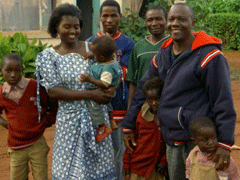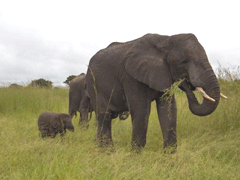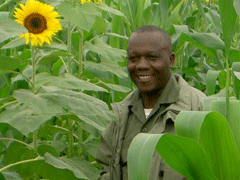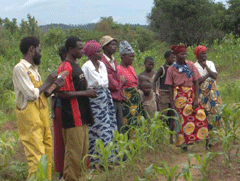Zambian Goldman Prize Winner
Air Date: Week of May 4, 2007

Hammer working with villagers near his home (Photo: John Antonelli/Goldman Environmental Foundation)
Hammerskjoeld Simwinga of Zambia won this year’s Goldman Environmental Prize for Africa. Simwinga works to promote community development and wildlife conservation in the North Luangwa Park region of his country. He tells host Steve Curwood about the challenges he's faced and his plans for the future.
Transcript
CURWOOD: It’s Living on Earth. I’m Steve Curwood. Each year the Goldman Environmental Prize recognizes seven grassroots environmental activists from around the world with prizes of $125,000.This year the winner from Africa comes with a story that may be familiar to listeners to Living on Earth. The tale of Hammerskjoeld Simwinga of Zambia, figures prominently in the book, Secrets of the Savannah. It was written by American zoologists Mark and Delia Owens, who last appeared on our show about a year ago.
They had worked with Mr. Simwinga on elephant conservation and community development in Northern Zambia. The trio helped villagers start a cottage industry pressing cooking oil from sunflowers as an economic alternative for rampant elephant poaching in the area, especially in North Luangwa National Park. Influential commercial poachers and government officials pushed the Owenses out of Zambia a few years ago and Hammerskjoeld Simwinga was left to pick up the pieces. Mr. Simwinga came to the U.S. to receive his Goldman Environmental Prize and joins us now in the studio.
Congratulations!
SIMWINGA: Thank you, thank you.
CURWOOD: How did you get that name, Hammerskjoeld? It doesn’t sound that African to me.
SIMWINGA: No, no it’s Swedish. You know, in the early 60’s we had Dag Hammarskjold who was the Secretary General and he was on a mission to Africa. And sadly he crashed in Ndola, which is our second capital city in Zambia. And by that time dad was working at the nearest hospital and was among the first people to rush to the scene and unfortunately it was a disaster. But a few years later when dad had his first-born he thought of naming him Hammerskjoeld. And that’s how I was named Hammerskjoeld.
CURWOOD: And everybody calls you Hammer.
SIMWINGA: And now everybody calls me Hammer because apparently it is a long name for everybody. And also it’s difficult to write it. The spelling is quite difficult, so I’ve decided to shorten it by Hammer, but I love to be called Hammerskjoeld.
CURWOOD: For the UN Secretary General who was killed in a plane crash there.
SIMWINGA: Yeah, on a noble mission to Africa.
CURWOOD: The very first UN Secretary General I believe.
SIMWINGA: Yeah, he was.
CURWOOD: So, where exactly are you from?

Hammer with his wife and children (Photo: John Antonelli/Goldman Environmental Foundation)
CURWOOD: So, what exactly do you do there?
SIMWINGA: There I’m working with the community because initially this community was more involved in the illegal hunting. And the rate the park was being hunted it was going to maybe by this time sterilized.
CURWOOD: Sterilized, you mean, all the big animals gone?
SIMWINGA: Completely gone. And this is a park, which is about 6,400 kilometers squared. If all big animals were wiped out then this would be just an empty wilderness. I’m also working with the community in terms of providing them with the alternatives. That is in terms of agriculture and cottage industries. This is in terms of promoting bee keeping, fish farming resource.
CURWOOD: So, what inspired you to do this work? If the local business is poaching and illegal hunting why don’t you join with them?
SIMWINGA: Basically it was a sad situation, which maybe inspired me, because at one time we managed to see ten in a day dead elephants with all their tusks gone. And these are creatures, to which to my heart I think it’s our role as human beings to give them the protection. The thing which also made me really inspired and made me really do something was when the herd of an elephant was killed and only the baby elephant remained and had nowhere to go. It started to follow the people wherever they went. So, to me, that really moved my heart and I said we should do something.

Elephant family in the North Luangwa National Park, Zambia. (Photo: John Antonelli/Goldman Environmental Foundation)
SIMWINGA: Basically, yes, because they were doing their study in the park and their study was constantly disturbed by the heavy poaching which was going on there. Thus when again the thought of maybe increasing the area of intervention. Not only looking into the affairs of the research and the science behind it, but also look at how they can empower the community. So, that’s how they came up with the community development program as another way of saving the national park. So this is where I was hired in, in 1994. To come in and spearhead the community development program. Basically to do more on agricultural development and business entrepreneurship.
CURWOOD: So before you were working on your own dealing with poachers. You were very concerned.
SIMWINGA: Yes, yes.
CURWOOD: And then the Owenses came along and they hired you to help them with their project.
SIMWINGA: Definitely yes.
CURWOOD: So you combine forces.
SIMWINGA: Definitely yes. That was a good team because I found a couple who had the passion for the animals. And also the passion for the country and the passion for the community. So they managed to also raise funds to help the community program by bringing in simple machines like the oil presses. This also helped the community develop bigger interest in preserving the wildlife because now we linked the community program and also the wildlife conservation part of it.

Hammer in a sunflower field (Photo: John Antonelli/Goldman Environmental Foundation)
SIMWINGA: It has never been easy especially conserving wildlife in Africa. Not only in Zambia, but all over Africa because of the poverty levels. And when you try to maybe to stop illegal people doing something wrong then they will ruin your life because you are kind of interfering with their incomes. So definitely it was not only the Mark Owens who were in danger but also the people who were working on the project and also the game scouts who were implementing the law enforcement part. The biggest part was to have the community on our side. And that’s why the community program came in, so that we could offer an alternative so that we could also do ecological management program with them.
CURWOOD: So, what happened? The Owenses they could leave and come back to America. You couldn’t leave. That’s home for you, Zambia.
SIMWINGA: Yeah, it was home so I could not leave. We had a government at that time which was corrupt, of course. But we were quite strong because we stood for conservation. And then that’s how the Mark Owens in fact they were on their holiday here in U.S.A they just heard that their project had been stopped. I had no pay, I had nowhere to go, I had no transport to continue the program. But because of what I said that I was inspired with what was already on the ground I had to stand up because the picture of the baby elephant was still in me. The picture of the community still needing someone to motivate them to go ahead was still in me. They were my people. It is my country. It was my park. I could not come to the United States so I had to remain.

Hammer working with villagers near his home (Photo: John Antonelli/Goldman Environmental Foundation)
CURWOOD: So you founded your own organization then?
SIMWINGA: Yes definitely because I needed to work with something which is legal. Immediately the Owens left, which meant of course the project they were working on ceased to be there. But for me to operate effectively and be protected by the law of the land I had to register an NGO to continue the work. Of course I still maintained the North Luangwa Conservation Project because that was my major strength. And also I still wanted to continue with the community development program. Hence this program has two thrusts: conservation of wildlife and also community development.
CURWOOD: So it’s the North Luangwa Wildlife Conservation and Community Development Program?
SIMWINGA: Yes, which means we have to develop the wildlife and also have to develop the community. So I have to find the balance of the two, which I think we’ve managed to do.
CURWOOD: Of course everyone asks you about this. How safe is for you now? I mean the Owenses were in danger I think people one time, they were looking for you too.

Villagers at an agricultural fair near the North Luangwa National Park, Zambia (Photo: John Antonelli/Goldman Environmental Foundation)
CURWOOD: So, Hammer, where are things now in North Luangwa?
SIMWINGA: I think things are better. Everyone is happy. The community is happy because places where they never used to see an elephant, children who never saw the elephant especially those who were born in the late 80’s, 90’s, they just heard of an elephant. But this time these elephants are moving in their villages. And now we are having a problem on how to control them from raiding their crops. And likely enough and happily enough I’d say we’ve found a kind of simple solution, which has worked for the past three years. We’re using chili- making a chili fence. This is a very humane way, I must say very environmentally friendly way, of protecting the elephants into the people’s fields. The chili is planted either as a boundary to the crop and the other one is we are using pepper chili, you put a small fiber then smear your chili, just a single rope. I mean you cannot imagine that an elephant would be scared to pass through a single rope but that because of the chili, which is a terrible repellent, I don’t know the science behind it but an elephant will never come near a chili plant. And that has worked. And at the moment everyone is growing chili to protect their fields.
CURWOOD: Well, you can imagine, I mean, if you’ve ever had any pepper, sprinkled it out, it makes you sneeze, right?
SIMWINGA: Oh yes, yeah.
CURWOOD: So now you’re an elephant. You know how much nose an elephant has? That’s a lot of nose!
SIMWINGA: Yeah, and the air it takes in!
[BOTH LAUGH]
SIMWINGA: So, I would say the pack is healthy. Both the community and the Zambia wildlife authority and us as a project, we’ve found a better ground to discuss and say how we can save this unique resource.
CURWOOD: How are the villagers doing economically now after transitioning from substance poaching to the small business of growing fish and sunflower and doing cooking oil and such?
SIMWINGA: Yeah, so we’re seeing increased food production. And also increased sales. We’re also seeing increased incomes because we see people buying bicycles. We see people sending their children to school. So we are having a lot of positive indicators which are showing us that there is an increased income circulation. The economy of the village is expanding, because previously you could not find a young man who after producing a certain crop would put up a small tack shop, so there is reinvesting of the money in the community. So, basically it is a healthy community. The children are happy. They are running around. We’ve also managed to help them build community schools. So most of the time our children are spending time at the school. So that has really increased the strength of the community. In short, I would say the community has been empowered through this program.
CURWOOD: Now what about tourism? Is there any tourism?
SIMWINGA: Tourism has also developed tremendously. This is a park which was written off a few years ago about ten, 15 years ago. But today it is a park which is growing at a very fast rate. A lot of people have applied to do their operations there. Apart from that we are also seeing an increased interest of the local community trying to visit this park to see the results of their work after they have been involved for so many years. So we’re seeing a lot of interest both by externals tourist and the local people.
CURWOOD: So what are the lessons for Zambia, the rest of Africa, the world even, in what you have discovered to protect these elephants?
SIMWINGA: Yeah, the elephants have to be protected and it is the role of everyone to do it because these big mammals, they signify the greatness of Africa and the continent. Because if they were wiped out and they were not protected then the whole essence of having Africa would not be there because, to me, I believe, to each continent God gave its own habitation. Wildlife, big animals like buffalos, elephants they are part of our blood, so if they are not there then the continent is not there.
CURWOOD: So, what do you plan to do with the award money?
SIMWINGA: The award money, basically, I think it will just help me move ahead with the cause. Because again, having saved the North Luangwa and the situation in which it is, it is safe and sustainable and it can continue. The communities have been empowered and no one can go through it and start poaching again because they are getting more money from the businesses which they are doing in the community. Now, I think this prize money will just help me reach another place, which I have been called several times by the local chief there to go and introduce a similar program for his people. So basically to give me another mileage to do what I love most.
CURWOOD: You’re not going to do anything else. This is your life work?
SIMWINGA: I think so. I think now it’s in my blood and every time I am thinking on how to make the environment better for everyone.
CURWOOD: Hammerskjoeld Simwinga, everybody calls you Hammer though, right? Does that mean a tough guy, the Hammer?
SIMWINGA: Yes definitely yes, hammer is something very tough you have to nail the nails down into hard rock.
[BOTH LAUGH]
CURWOOD: Hammer Simwinga is the Goldman Environmental Prize winner this year from the continent of Africa. Thank you so much.
SIMWINGA: Great, my pleasure.
CURWOOD: You can learn more about Hammerskjoeld Simwinga’s work in Zambia as well as this year’s other Goldman Environmental Prize winners at loe.org.
Links
Living on Earth wants to hear from you!
Living on Earth
62 Calef Highway, Suite 212
Lee, NH 03861
Telephone: 617-287-4121
E-mail: comments@loe.org
Newsletter [Click here]
Donate to Living on Earth!
Living on Earth is an independent media program and relies entirely on contributions from listeners and institutions supporting public service. Please donate now to preserve an independent environmental voice.
NewsletterLiving on Earth offers a weekly delivery of the show's rundown to your mailbox. Sign up for our newsletter today!
 Sailors For The Sea: Be the change you want to sea.
Sailors For The Sea: Be the change you want to sea.
 The Grantham Foundation for the Protection of the Environment: Committed to protecting and improving the health of the global environment.
The Grantham Foundation for the Protection of the Environment: Committed to protecting and improving the health of the global environment.
 Contribute to Living on Earth and receive, as our gift to you, an archival print of one of Mark Seth Lender's extraordinary wildlife photographs. Follow the link to see Mark's current collection of photographs.
Contribute to Living on Earth and receive, as our gift to you, an archival print of one of Mark Seth Lender's extraordinary wildlife photographs. Follow the link to see Mark's current collection of photographs.
 Buy a signed copy of Mark Seth Lender's book Smeagull the Seagull & support Living on Earth
Buy a signed copy of Mark Seth Lender's book Smeagull the Seagull & support Living on Earth

